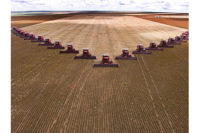Business Strategies
How to profit in uncertain times
Depart from “conventional” wisdom in 2014 to improve your chances of success.




In the protein business, we are venturing into a market with relatively inexpensive feed ingredients. The typical M.O. of producers is to dramatically increase production as a way of storing those cheap feed ingredients as protein. Historically, that has resulted in oversupplied markets and is also a major reason why chicken producers continue to steal market share from beef and pork producers. Chicken producers benefit from a much shorter lifecycles and can react more quickly to changing market conditions than large animal protein producers.
Many industry experts forget to factor in the average increase in weight per animal. I challenge my learned colleagues in the protein business to only build supply to a reasonably, realistic business plan and not be the one to oversupply, pushing the market lower. As Tyson Foods and JBS have significant shares in all three proteins, damages to any of the categories could negatively impact some portion of their company. They both have enough critical mass to create an oversupply in the market.
You would be doing your company a service by applying good business practices that encompass a larger, global view. Find a way to improve the value of your product — not just the supply. In particular, the chicken industry must resist the temptation to grow monster birds due to the inexpensive feed just because it can. This will help mitigate an oversupply and will keep pricing and profits more stable over the long run. As we enter into this 2014 sales cycle, we should continue to look at all the indicators and make adjustments accordingly.
There’s certainly no guarantee that feed ingredients will stay cheap through the end of 2014. We are truly in a global market where a hiccup in any major basic grain-growing area can result in a worldwide shortage that will push prices up sharply on any affected commodity.
A farmer that grows corn, every three to four years at a minimum, needs to rotate to soybeans simply to replenish the soil with needed nutrients to maximize yield. In fact, yield gets lower every year the crop is not rotated. We all know it has been very profitable to grow corn the last few years, and as a result, many producers have delayed rotating to soybeans. Yet, 2014 may be the year grain/feed ingredients producers will be motivated to rotate for multiple reasons:
- Because other growers in the world have built significant amount of acreage in soybeans, the American farmer no longer controls the soybean market. (See chart below)
- American growers produced too much corn in 2013, causing the current low feed market we are experiencing.
- Soybeans are more drought resistant and, as aforementioned, return needed nutrients to the soil. (according to http://www.geohive.com/charts/ag_soybean.aspx)
With farmers all over the globe continuing to increase soybean production, the USA no longer has the lion’s share of the market. The industry should continue to study ways to incorporate soybeans into feed formulas to improve feed conversion and accelerate growth as a benefit from this valuable commodity.
The U.S. protein industry finally got relief from the government on the renewable fuel mandate. Many of you in the protein business worked very hard to make that happen. Big oil also played a significant role behind the scenes, annoyed by the lack of control it had of its own markets, with big oil companies spending their significant lobby budgets to help influence the change.
Unfortunately, the majority of the corn supply will still be consumed to make ethanol for the foreseeable future. There is no relief in sight from the many government officials who have never been to a farm and have no clue how food is produced.
If Hillary Clinton chooses to run for president in 2016, she would be a heavy favorite to win. We must keep pressure on our politicians to advance research for more efficient solutions and more relief from fuel standards that misuse valuable feed stocks.
I look forward to seeing more of you than ever at this year’s IPPE show in Atlanta in January as the key players in the beef, pork and poultry industries avail themselves of the great opportunity of joining each other and helping move the business forward.
Looking for a reprint of this article?
From high-res PDFs to custom plaques, order your copy today!








